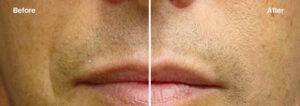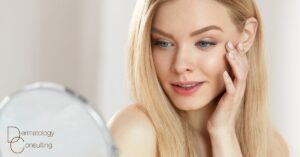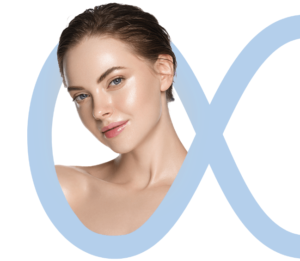Volumising Dermal Fillers
Restorative Fillers: “Liquid Facelift”, “8 Point Lift”, and “MD Codes”
Many of the facial changes that occur with age are due to loss of volume. In recent years it has been established that there are separate fat compartments in the face, and as we age these fat compartments lose volume, contributing to the sagging and sinking of the ageing face. In addition, bone is also gradually resorbed with age (including the jawline, central face, and around the eyes), and the ligaments holding facial structures in place become lax, exacerbating this sinking and sagging. The result is the gradual deflation of the shape of the face, from the round plump face of the baby and teenager, to the deflated and sagging face of the elderly. Superimposed on that is the loss of skin elasticity and collagen due to intrinsic ageing and external factors, particularly sun-damage.
Explore Topics On This Page
- How can this loss of volume be restored?
- What types of filler can be used?
- What brands of fillers are used at Dermatology Consulting?
- What are the “8 Point Lift” and “MD Codes”?
- What is the Concept of PHI and how can it be applied to fillers?
- On what sites of the body can fillers be used?
- What problems can occur with fillers?
- What is the place of high resolution ultrasound guidance in fillers?
- How long do fillers last?
- “Tear Trough” Treatment
- How can I decide the best approach for me?
How can this loss of volume be restored?
One way of restoring this loss of volume is the use of fillers. When these are injected, they can replace the loss of fat and bone.
What types of filler can be used?
Recent advances have led to the development of new fillers of different strength and character, which can be chosen to deal with different layers of the face. At Dermatology Consulting, we usually choose hyaluronic acid fillers. This is because hyaluronic acid occurs naturally as a form of sugar in the body, so it is extremely rare for the body to develop an allergic reaction against it. Furthermore, a natural antidote exists against hyaluronic acid (called hyaluronidase), which can effectively and quickly dissolve the hyaluronic acid filler if one dislikes the result or if there are problems from it.
Sculptra®Aesthetic is another filler that is occasionally used. It is poly-L-lactic acid, which is the same material used in dissolving stitches. It consists of fine granules that are diluted down with sterile water and injected under the skin. The granules then stimulate gradual collagen production around themselves.
Radiesse is another brand of filler which is occasionally used. This is composed of a product called calcium hydroxylapatite which stimulates collagen production. The body eventually breaks down the Sculptra or Radiesse particles but they will have helped stimulate new collagen in the meantime.
Sculptra and Radiesse can be used at their standard concentration, but when diluted down they can also be used to stimulate diffuse collagen production, particularly at sites off the face where one can be concerned about “sagging” e.g. thighs, upper arms, buttocks (a technique sometimes described as “Biostimulation”.
What brands of fillers are used at Dermatology Consulting?
At Dermatology Consulting a number of different fillers are used, each chosen for their particular properties of strength and elasticity. The selection of fillers used will depend on the area to be treated and the individual patient’s problem. For example, when restoring loss of volume of the face and correcting sagging skin, fillers with high strength and cohesivity, such as Voluma®, Belotero Intense, Revanesse Ultra/Shape, or Perlane are used deep in the skin to provide structure and support. When restoring volume more superficially, thinner, less cohesive fillers are used, e.g. Volift®, Restylane, Revanesse Contour or Belotero Volume. When treating fine lines, lighter fillers that spread out easily are used, e.g. Belotero®Soft, Vobella®, and Restylane®Vital. This global approach both restores the volume and soft contours of youth as well as improving fine lines. Such an approach is often referred to as a “Liquid Facelift”.
Such “Liquid Facelifts” can be used to rejuvenate the face in individuals who either do not want or who are too young for a facelift. They are best used in combination with other treatments as part of a whole treatment plan (e.g. in conjunction with good skin care, neuromodulating wrinkle reducing injections, Sofwave®and other resurfacing or fractioned lasers to soften wrinkles).
We use Sculptra and Radiesse diluted down to achieve biostimulation at sites off the face e.g. neck, chest and upper arms.
What are the “8 Point Lift” and “MD Codes”?
The “8 Point Lift” and the “MD Codes” is a method for injecting fillers in the face developed by Dr Mauricio de Maio, a skilled plastic surgeon from Brazil. It is designed to maximise the re-volumising effects of strong fillers, such as Voluma™, by injecting certain sites to achieve optimal improvement. Dr Farrell has adapted the principles of this approach and included some additional techniques she has developed from many expert injectors she has learned from in the USA, Canada, UK and France. The aim is to achieve a restoration of the volume that was lost with time and to restore the original contours, but not excessively, to achieve a “natural look”.
What is the Concept of PHI and how can it be applied to fillers?
The concept of PHI is based on the fact that the human eye and brain seem to instinctively recognise and appreciate natural symmetry. In fact, most natural objects and works of art that are universally recognised as beautiful or aesthetically pleasing, when analysed, seem to be composed of proportions using PHI or the “golden ratio.” The ancient Greeks knew about this in their architecture and renaissance artists, particularly Leonardo da Vinci, recognised this. It has also been observed in international surveys that faces, both male and female, of all ethnic origins that are universally considered attractive generally follow the principles of PHI. This seems to be regardless of ethnicity of the observer or subject. The principles of PHI can be applied when doing fillers, not to make everyone look the same (we should all have our unique facial features and personality) but as a guide to ensure that the fillers are not overused and are only used to achieve natural results. Dr Farrell has for many years been interested in how to use PHI to achieve optimal but natural looking results with fillers.
On what sites of the body can fillers be used?
Fillers can be used at any site where volume has been lost. They are most frequently used on the face, but other sites can be treated, including the hands, neck, and chest.
“Biostimulation” with Radiesse or Sculptra can be particularly helpful on areas of skin laxity e.g. thighs, upper arms and neck.
What problems can occur with fillers?
It is very unusual to react to hyaluronic acid fillers as they are composed of sugars that occur naturally in the body. Therefore, it is very rare for allergic reactions to them to occur, unlike the earlier collagen fillers which previously had a high chance of producing allergies.
It is very important that any practitioner injecting fillers has a thorough knowledge of anatomy to avoid fillers being injected into blood vessels, which could cause loss of skin in the involved site or even rare cases of blindness and even death. For this reason, it is important that fillers are injected in the correct anatomical sites. Where possible, at Dermatology Consulting we use cannulas rather than needles for most sites, which reduces the chance of injury to blood vessels and reduces the chance of bruising.
In certain areas, for additional safety, we also use a high resolution ultrasound guidance machine to identify the anatomy and the position of blood vessels to reduce the risk of injecting blood vessels, optimising safety.
When using hyaluronic acid, there is also the advantage that there is a natural antidote that can dissolve the filler if necessary. Sometimes it is necessary to dissolve fillers that have been injected incorrectly by other practitioners and that are causing unwanted bumps or swelling, and by using the high resolution ultrasound we can accurately dissolve any unwanted/suboptimal filler from other practitioners and then replace it with better filler if desired. Fillers can also sometimes migrate, and although it was thought that hyaluronic acid fillers dissolved naturally over 6-18 months, recent years have show that hyaluronic acid fillers can persist for many years. Therefore, sometimes fillers that looked good one year may not look so good a few years later. However, having hyaluronidase gives the option of allowing the filler to be dissolved if so desired.
What is the place of high resolution ultrasound guidance in fillers?
At Dermatology Consulting, we are committed to providing the safest treatment techniques. Dr Farrell has invested in many years of training, particularly overseas in Europe and the US, with many of the world’s best injectors and has developed her own techniques using the best of what she has learned for her patients. We are one of the first clinics in the South East of England to have invested in one of the highest resolution ultrasound machines on the market to accurately identify patients’ anatomy. This can be particularly helpful in certain areas to identify blood vessels to avoid injecting into them and to maximise safety.
The high resolution ultrasound can also locate the position and type of previous fillers (sometimes patients are not certain what previous practitioners have used and it can be helpful to know). The ultrasound can also be used to accurately guide precise placement of hyaluronidase to dissolve unwanted/problematic fillers done by other practitioners.
How long do fillers last?
Hyaluronic acid fillers can last from between 6 months for very fine fillers, to 24 months for thicker fillers. The fillers are broken down naturally by the body. The presence of the fillers helps to stimulate some production of the body’s own natural collagen, so there is some long-lasting improvement. Most patients who decide to have fillers have an initial course of fillers to achieve the result they want and then have occasional repeat sessions every 12-18 months to maintain the improvement.
“Tear Trough” Treatment
Many individuals become more aware of noticeable “tear troughs” developing under their eyes as they age. The natural process of ageing can deepen these hollows, causing them to appear darker. Patients often dislike this as they believe the eyes look more tired, heavy, and sad. Dr Farrell offers a range of treatments to help improve the appearance of this area.
What causes tear troughs to develop?
Hollow-looking tear troughs are caused by a steady loss of volume of the structures of the face. With age there is a loss of the fat compartments and a gradual loss of bone, particularly of the central face and orbit (eye socket). In addition, the overlying skin starts to lose collagen and elastin. All these changes can result in hollows developing under the eyes and the appearance of dark shadows.
How can tear troughs be treated?
Fillers can be used to replace the loss of volume and fill in the tear troughs. If the tear trough is very deep a filler that will not migrate easily such as Belotero® Intense can be placed deep under the tear trough. On very shallow tear troughs, very soft, thin fillers (e.g. Restylane®Vital, Belotero®Soft, and Redensity II®) are used to avoid the filler being visible under the delicate skin of the eyes. At Dermatology Consulting, Dr Farrell will often use cannulas to reduce the chance of bruising. It is always important to “undertreat” tear troughs with fillers, because the fillers may naturally hydrate and swell a few months later, and this can result in “puffiness” under the eyes.
In addition, the texture of the skin can be improved with skin care products, including retinoids and antioxidants. Lasers can also contribute to improving the texture and tightening the skin. Such lasers include Fraxel® Restore, Fraxel® Repair, Fotona®, Sofwave®, PicoWay® and Ultrapulse® Alpha by Lumenis. The best results are usually obtained by a combination of these methods, and we will often start with these non-filler options first as they will reduce the amount of filler required.
How can I decide the best approach for me?
Dr Farrell can discuss the best treatment, or combination of treatments, to deal with your individual concerns.



